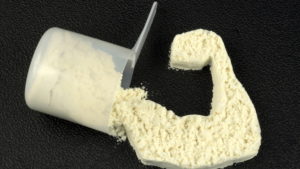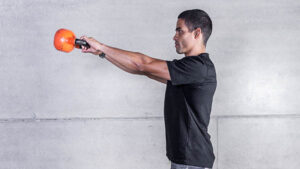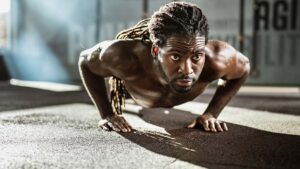
Building muscle and losing fat simultaneously is, let’s face it, the holy grail of body transformation. But look no further, as HFM called on sports nutritionist Matt Lovell to show you how
Many experts contend that it is impossible to build muscle and lose fat at the same time. They argue it’s more efficient to focus on building muscle and then getting lean or, conversely, getting lean then building muscle. But having worked with Olympic athletes, international rugby players and the average gym user, I’ve found it is possible to do both. But you need to be strategic with your training, nutrition and recovery, and monitor your results closely.
Your results will primarily revolve around the understanding of how to manipulate one hormone. Mastering it is the key to managing your body composition for the rest of your life. That hormone is insulin.
How insulin builds muscle
Insulin is produced when your blood sugar levels rise above a certain point, which is dependent on the food you have eaten. Its role is to reduce blood sugar to within an acceptable range, by removing the surfeit from the blood. Any surplus sugar will be used to top up your sugar stores (glycogen) in your muscles and liver. When they have been replenished, the rest is converted into fat and driven into the cells. This is how you get fat, by eating too many high-carb foods.
However, you can use insulin to help build muscle. Do this by eating a high-carb meal to spike insulin levels and combine it with a high-protein food source, so that protein gets driven into the muscle cells to help build and repair new muscle cells. Most of you will be doing this already in the form of a post-workout whey protein shake.
Many people who are overweight to begin with have a problem in this regard. Because of what and how they have eaten, their body is not as receptive to the effects of insulin. If you are over about 15 per cent body fat then you are likely to be somewhat insulin-resistant – this means that you have to produce more insulin to get the blood sugar-lowering and muscle-building effects. This can be reversed by following a low-carb diet plan for as little as two weeks; find one at www.fourweekfatloss.com. If you are around the 15 per cent body fat mark, there is not as much of a need to reset your Building muscle and losing fat simultaneously is, let’s face it, the holy grail of body transformation. So HFM called on sports nutritionist Matt Lovell to show you how body’s sensitivity to insulin; doing it for a few weeks won’t do you any harm, though.
Converting fat to muscle
It’s physically impossible for fat cells to turn into muscle cells. What we can do is learn to use our fat stores for day-to-day energy and then fuel muscle growth with pre- and post-training shakes containing plenty of protein, carbs and amino acids.
Monitoring is important because it’s impossible to give exact figures on how much different people should eat, as we all react differently to food. In the meal plan, I’ve outlined some starting points – adjust the carbohydrate level depending on your results. If you’re losing too much fat and not seeing any muscle growth, have more carbs. If you’re getting heavier quickly without dropping any fat, reduce your carbs.
Exercise and training
Obviously, you need to be doing some resistance-based weight training in the gym in
order to build muscle. Here are some basic principles to follow:
Train four to five times a week
You can get OK results with three longer sessions a week, but your progress will be
slower and your diet needs to be stricter.
Include strength-based sets in your muscle-building sessions
Lifting heavier weights for up to 5 reps, with longer rests, will improve your strength. Focus on big muscle groups So do legs, back or chest rather than biceps and triceps, particularly if you want to lose fat.
Super-sets improve time efficiency
For example, start with squats, then on to single-arm push-ups, then straight on to chins. Rest for one-and-a-half to two minutes, then repeat three to four times.
Change your programme regularly
At least every three to four weeks.
Supplements for musclebuilding and good health
Firstly, it’s vital to be eating a good, clean diet, that’s additive-free and as close to nature as possible. Just because you are supplementing with vitamins and minerals, that doesn’t mean you can get away with eating pizza and burgers the rest of the time. If you eat the meals in the plan, you will be well on the right track. Before you consider taking specific muscle-building supplements, there are certain supplements for good health that you need to be taking first. They’ll help put your body into the best possible shape to effectively lose fat and build muscle. They are:
Multivitamins and minerals
Fish oils: Aim to be consuming 1000mg of eicosapentaenoic acid (EPA) per day (make sure you always read the label and take the correct dosage). Vitamin D: Aim for 5000IU per day during the winter, to avoid deficiency; in summer, we get most of our vitamin D from exposure to sunlight. We also get vitamin D from oily fish (for example salmon and sardines), eggs and meat.
Whey protein and carbohydrates
The pre- and post-workout protein shake is the most important for muscle-building. This needs to be a mixture of whey protein and carbohydrates. The carbs in these drinks will spike your insulin levels, helping the protein enter your muscle cells. I advise on your training days to have 3.5 calories per kilo of weight. Therefore, a person who weighs 100kg would have 350 calories before and after training.
Creatine monohydrate
This enables you to lift more towards the ends of your sets. It may also cause some water gain in the muscle, which can help with the synthesis of new tissue.
Beta alanine
This is an amino acid that will enable you to work harder towards the end of your sets, so you will be able to lift more weight and create an improved training effect. Aim for six grams per day (in three doses of two grams). You may get a tingly feeling on your skin with this supplement, though this lessens with time.
Boosting your natural levels of growth hormone
You can do this with interval training and by having an afternoon nap. I’ve also formulated a blend of amino acids into a specific product, GH Loader, to help you recover from your training sessions, boost fat loss and build muscle by supporting production of growth hormone. This is more important for individuals over 30.
Matt Lovell has been the England rugby team’s sports nutritionist since 2002. He also currently works with Manchester City and Tottenham Hotspur football
clubs. Based in London, he runs seminars for people with an interest in sports nutrition and fitness (see www.sportsnutritionvlog.com/2013-seminars)
This move is king when it comes to core. Learn perfect form to reap maximum benefits and avoid injury.
The bounce back begins. There’s no doubt that the Covid-19 crisis curtailed fitness routines for millions, as competitions were cancelled, training programmes postponed and events put on […]



